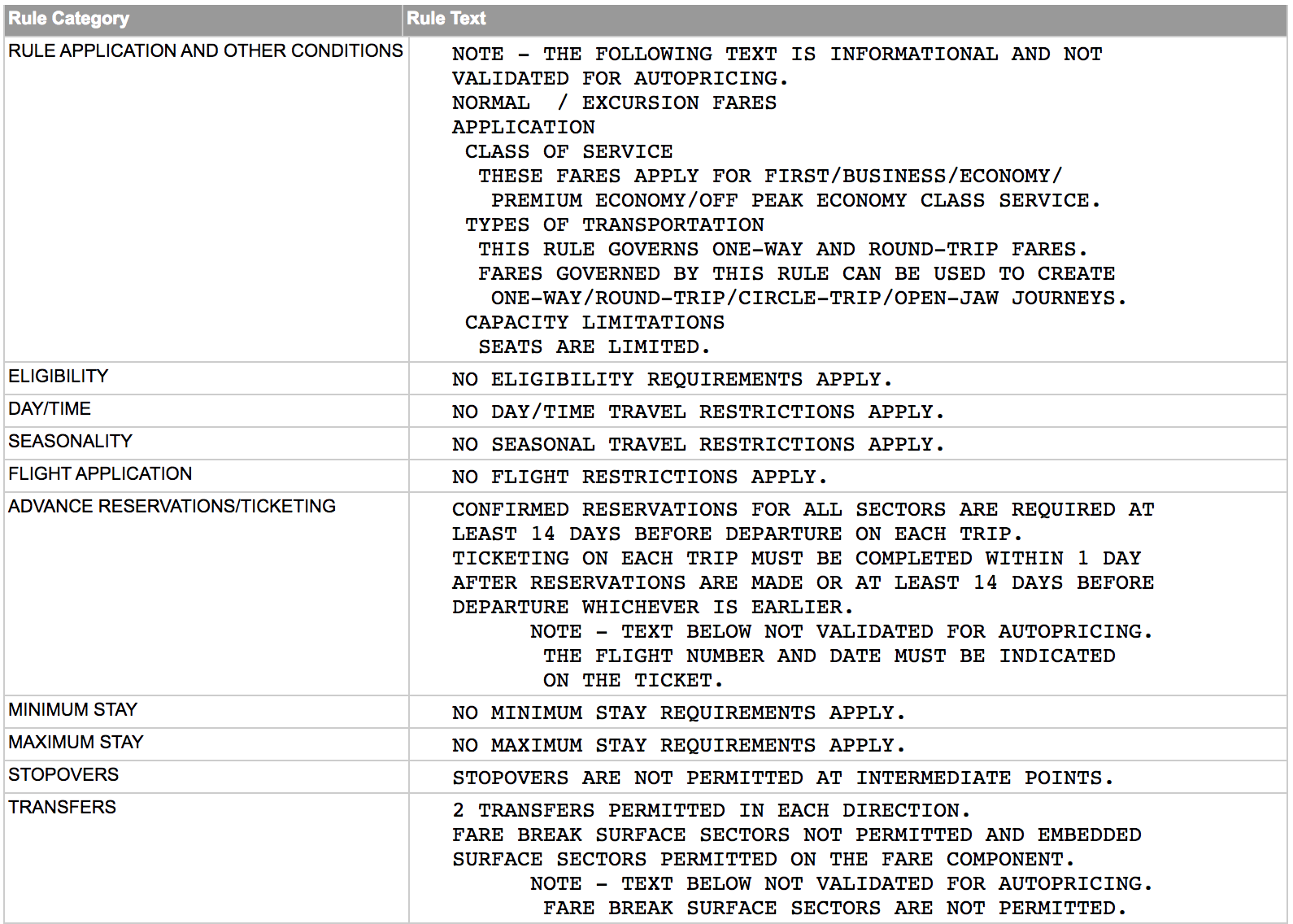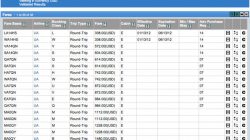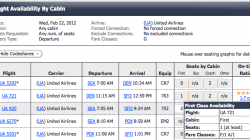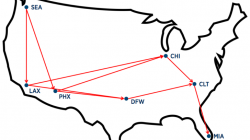Earlier this morning I wrote a post on how to find airline fares, but I didn’t go very far into the rules that make those fares work. To book a ticket you need to find available inventory in the right booking class (usually the first letter of the fare basis code) and also meet the rules of the fare. That means there could be inventory available, but some violation of the rule requires you to use a different, more expensive fare with less restrictive rules.
Understanding fare rules will make it possible for you to improve your search by looking at other dates and different flights. The truly expert traveler will start by looking for a cheap fare and then finding flights and inventory that match these rules.
This is the reverse of the usual booking process that starts with stating all your preferences up front (the essential purpose of ITA Matrix advanced routing language). On the other hand, the rules can sometimes let you choose different routing language to make your search on ITA Matrix more effective by, say, excluding codeshares or looking for a specific flight number.

In this post I’m mostly explaining a few key terms that you may run across when reading fare rules. I’ll provide some examples of actual fare rules in future post to show how you can put this lesson into practice.
Segment/Leg
These are the individual flights where you enbark and debark an aircraft. Again, simple enough, but most people in my experience use the word “flight” instead of “segment.”
Nonstop Flight
It’s truly what it sounds like. You’ll need to fly from AAA to BBB without stopping.
Direct Flight
This is a deceptive ploy by the airlines. A direct flight refers not to the actual path the aircraft travels but whether the assigned flight number changes en route. For example, flight 123 may travel from SEA to LAX to JFK to LHR with gate and plane changes at each connecting airport.
This is a “direct” flight from Seattle to London, but the fact these four separate trips all share the same flight number doesn’t guarantee the airline will hold one flight if the preceding one is delayed. I discourage you of thinking that a direct flight is different from a normal connecting itinerary.
Transfer/Connection
Transfers are airports where you may stop along the way and transfer to a different aircraft. It’s simple enough, but sometimes the word “transfer” doesn’t always make sense to people who think of these as “connections.”
In general, you are permitted 4 hours to make a domestic connection and 24 hours to make an international connection. If you arrive after the last connecting flight of the day, you will be granted additional time until the next connecting flight the following morning (or another day if there aren’t daily flights). This can be a great way to take advantage of opportunities for mini-trips if you aren’t permitted a stopover.
Stopover
A stopover is a break in your itinerary to spend time in a connecting city. You may be traveling from New York to Dubai via London. Rather than spend three hours connecting in London, you can elect to stay there for a few days and have a second trip-within-a-trip. Sometimes this is free (especially on some award trips) and sometimes it costs $100 or so.
Permitted Routing
Permitted routing is the path you are allowed to travel using a fare. There may be several different options available, and typically a forward slash “/” will represent more than one option while a dash “-” indicates a flight between airports.
For example, the permitted routing could look like SEA-SFO/OAK/SJC-JFK/EWR-LHR. This example means you may travel from Seattle to either San Francisco, San Jose, or Oakland, then to either JFK or Newark (not La Guardia), and then to London-Heathrow (not to Gatwick or Luton). Unless a connection is specifically required, you’re also allowed to skip them. So you could fly from Seattle to JFK and not visit any of the Bay Area airports.
Co-terminals
These are equivalent airports as far as the fare rules are concerned. Frequently you will see something like SFO/SJC/OAK in the fare rules. It doesn’t necessarily mean the airline has flights between all of the city pairs listed in its routing rules (maybe you can only get to one by connecting elsewhere), or even that it operates any flights at all to some of those airports. Co-terminals often make a lot of sense due to geographic proximity.
However, co-terminals are at the discretion of the airline and the fare itself. There’s no requirement that nearby airports be treated similarly.
Maximum Permitted Mileage
Rather than specify a particular routing, international fares often specify a maximum permitted mileage. Say you want to fly from San Francisco to London. The MPM may be something like 14,000. With the exception of a few other rules like the maximum number of transfers and general region of these transfers, the only requirement is that you keep the total distance flown under 14,000 miles.
Unless you’re trying to force a crazy routing or having difficulty finding fare class availability, I wouldn’t worry about MPM. You can look up MPM with ExpertFlyer and KVS Tool though this information is not. As a result some airlines will have a policy that permits you to go over by a certain amount, like 10 or 15%, on award trips. On paid tickets, there may be a fare surcharge that matches the excess mileage.
Open Jaw
Open jaw trips are like a roundtrip but only involve a single shared airport. These may look like SEA-SFO-PDX or SEA-SFO//OAK-SEA. (Many people will use two slashes instead of one to indicate that there is a break in the itinerary as a result of a layover or open jaw rather than a choice between transfer airports.)
Generally the open part of a jaw must be a shorter distance than either of the two flown segments. A double open jaw is one where both ends are open, such as SFO-LAX//SNA-SJC, and these generally require combining two one-way fares.
Circle Trip
Like it says, you travel in a circle/triangle/other polygonal approximation. The itinerary will look something like SEA-SFO-RNO-SEA. Alternatively, a circle trip may mean a round trip but one that uses a different one-way fare basis codes in each direction. A true round trip would use a single fare basis code.
Combinability
Any time you are trying to combine two fares you will have to worry about combinability. Note that there ARE single fares that permit some crazy routings but get you back to the same place, like round-the-world fares. However, you can generally assume that anything other than a simple roundtrip or one-way ticket is going to require combining two fares. Usually most search engines will tell you when this is the case.
Examples of combinations include circle trips, open jaws (sharing only the origin or destination airport, not both), and end-on-end combinations (a combination of two roundtrip fares).
Because there are multiple fares are involved but purchased as one transaction, you might wonder which set of fare rules apply. It is very difficult to figure out how these rules work together, and it isn’t always easy to predict whether two fares will combine properly. However, you can generally assume that the most restrictive set of rules will apply. So if you are combining a non-refundable G fare with a refundable Y fare, then typically both fares will be non-refundable.
Add-on
You will usually see this written as “add-ons permitted” or “no add-ons permitted.” An add-on is an extra flight added on to the beginning or end of an itinerary. For example, you may have a roundtrip fare for SEA-FRA-SEA and want to add a one-way fare for SFO-LAX or SEA-LAX to the end to purchase both fares in one transaction. This kind of construction is a requirement for most fuel dumping.
Back-to-Back Ticketing
This is a practice forbidden by all airlines to my knowledge. It involves purchasing two separate tickets and using them out of order or using only parts of each ticket.
In the first example, using them out of order, you may buy two roundtrip tickets from Seattle to London but stagger the dates like so:
- SEA-LHR on the 1st (ticket A)
- LHR-SEA on the 3rd (ticket B)
- SEA-LHR on the 10th (ticket B)
- LHR-SEA on the 12th (ticket A)
Why is this forbidden? Perhaps there is a minimum stay requirement of seven days. Ticket A and ticket B both meet these requirements, qualifying for a cheaper fare. But the passenger is actually traveling on two separate roundtrips with only two days in London each time. He or she is circumventing the fare rules to pay less than required.
In the second example, intentionally using only part of each ticket, you may book the same tickets as above but only use the first leg of each. Maybe you don’t actually need to go to London twice, but it’s still cheaper to buy two tickets and throw away half of each rather than pay full price for a ticket that lets you stay less than seven days.
End-on-End Ticketing
End-on-end ticketing is when you place fare B within fare A. It is very similar to the first example of back-to-back ticketing. However, the fare rules will tell you if end-on-end ticketing is permitted, and there isn’t any particular reason why this wouldn’t be okay. It will look something like this:
- SEA-EWR (fare A)
- EWR-BOS (fare B)
- BOS-EWR (fare B)
- EWR-SEA (fare A)
United doesn’t fly directly to Boston from Seattle, but it does fly directly to each city from Newark. Perhaps the fares for each of those roundtrips together is cheaper than a single fare for Seattle to Boston that permits a connection. So you would buy fare A to get you between Seattle and Newark, and fare B to get you between Newark and Boston. However, they are all on the same ticket, not like what you saw above in back-to-back ticketing where they were purchased separately.





